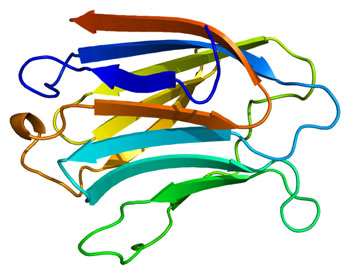Inhibition of Galactin-3 Reverses Insulin Resistance in Diabetes and Obesity Models
By Gerald M. Slutzky, PhD
Posted on 16 Nov 2016
Chemical or genetic inhibition of the protein galectin-3 (Gal3) was shown to reverse insulin resistance and glucose intolerance in mouse models of obesity and diabetes.Posted on 16 Nov 2016
Galectin-3 (Gal3) is an approximately 30,000 Dalton protein, which like all galectins contains a carbohydrate-recognition-binding domain (CRD) of about 130 amino acids that enables the specific binding of beta-galactosides. Encoded by a single gene, LGALS3, located on chromosome 14, Gal3 is expressed in the nucleus, cytoplasm, mitochondrion, cell surface, and extracellular space where it plays an important role in cell-cell adhesion, cell-matrix interactions, macrophage activation, angiogenesis, metastasis, and apoptosis.

Image: The Structural model of the galectin-3 (Gal3) protein (Photo courtesy of Wikimedia Commons).
Gal3 secreted by macrophages is elevated in both obese subjects and mice. Administration of Gal3 to mice caused insulin resistance and glucose intolerance, whereas inhibition of Gal3, through either genetic or pharmacologic loss of function, improved insulin sensitivity in obese mice.
Investigators at the University of California, San Diego (USA) described the mechanism for the effects of Gal3 on insulin resistance in the November 3, 2016, issue of the journal Cell. They reported that in vitro treatment with Gal3 directly enhanced macrophage chemotaxis, reduced insulin-stimulated glucose uptake in myocytes and adipocytes and impaired insulin-mediated suppression of glucose output in primary mouse hepatocytes. Gal3 bound directly to the insulin receptor (IR) and inhibited downstream IR signaling.
In mouse models of type II diabetes and obesity, bone marrow-derived macrophages were identified as the source of Gal3 that led to insulin resistance. Genetic or pharmaceutical removal of Gal3 returned insulin sensitivity and glucose tolerance to normal levels, even among older mice, without affecting obesity.
"This study puts Gal3 on the map for insulin resistance and diabetes in mouse models," said senior author Dr. Jerrold Olefsky, professor of medicine at the University of California, San Diego. "Our findings suggest that Gal3 inhibition in people could be an effective anti-diabetic approach."
Related Links:
University of California, San Diego














